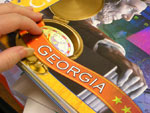Summarizing and Paraphrasing

Summarizing and paraphrasing is a useful practice for English Language Learners (ELLs) who struggle with understanding history text. By learning how to paraphrase, students can improve at reading and analyzing challenging text and gain a better understanding about what they are reading. Practicing key concept identification and rewording the material in another way helps ELL students understand the history content and the original text more fully.
There are a variety of ways you can teach your students to summarize and paraphrase key historical information. A few basic suggestions include:
- Reading the text twice: During the first read of the text, students should read to develop a general understanding of what is written. The second time, students should read the material more carefully and begin to identify key concepts.
- Using a dictionary or a thesaurus: Have a dictionary or thesaurus available for your students to use. While reading the material, they will encounter unfamiliar words. Using a dictionary to define unfamiliar words helps students understand what they are reading. A thesaurus helps students replace challenging words with vocabulary they are more familiar with. This helps them create a summary not only appropriate to their language skills but one they can understand.
- Working in pairs: Students who are new to the paraphrasing process may benefit from working with a partner who can help them look up words and explain the concepts using vocabulary that's understandable.
You might also try a few other strategies that focus on how students organize and record information:
- For beginning ELL students, graphic organizers can allow students to record ideas without having to rely on complicated language. But be sure to first teach your students how to use any graphic organizer you include.
- Providing outline-style notes to record key points can also be useful. It can help students learn to quickly record information and serve as an easily accessible source of information at a later point.
- Prereading activities can provide context for the upcoming reading, links to prior knowledge, and definitions for important vocabulary.
- For intermediate ELL students who can create complex sentences, paraphrasing the text into short paragraphs can be helpful. This gives them practice writing in English while also providing the opportunity to understand historical concepts.
The following is an example of summarizing and paraphrasing using the Digital History website:
Original text:
Most of the history that we acquire comes not from history textbooks or classroom lectures but from images that we receive from movies, television, childhood stories, and folklore. Together, these images exert a powerful influence upon the way we think about the past. Some of these images are true; others are false. But much of what we think we know about the past consists of unexamined mythic images.
No aspect of our past has been more thoroughly shaped by popular mythology than the history of Native Americans. Quite unconsciously, Americans have picked up a complex set of mythic images. For example, many assume that pre-Columbian North America was a sparsely populated virgin land; in fact, the area north of Mexico probably had seven to 12 million inhabitants. Also, when many Americans think of early Indians, they conceive of hunters on horseback. This image is misleading in two important respects: first, many Native Americans were farmers; and second, horses had been extinct in the New World for 10,000 years before Europeans arrived.
From: Mintz, S. (2007). "The First Americans." Digital History, retrieved October 17, 2010 from http://www.digitalhistory.uh.edu/database/article_display.cfm?HHID=657
Summarized and paraphrased text:
A lot of our knowledge of history comes from movies, stories, and television. Not all of this knowledge is true even though we might think it is.
Native Americans have had a lot of myths created about them. For example, we think there weren't very many people living back then in North America when there were really millions and millions. We also think Indians rode horses when horses weren't even around then.